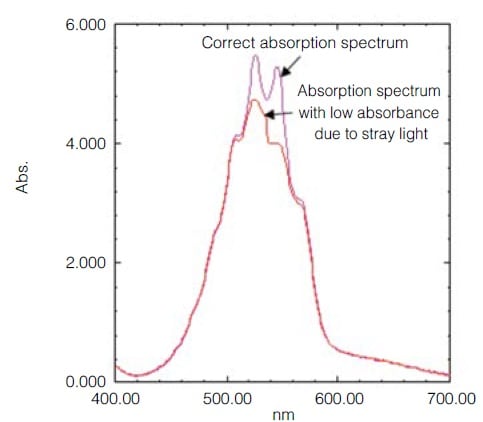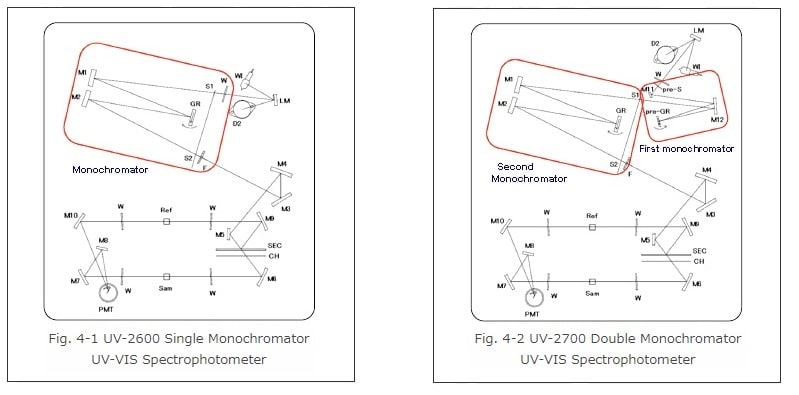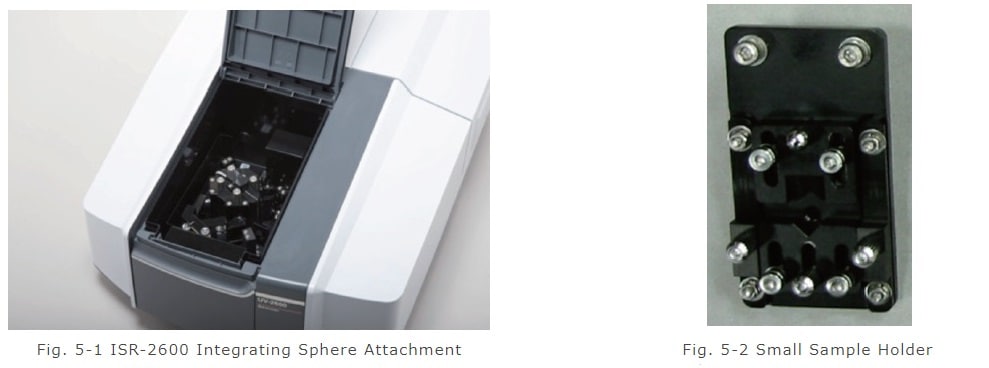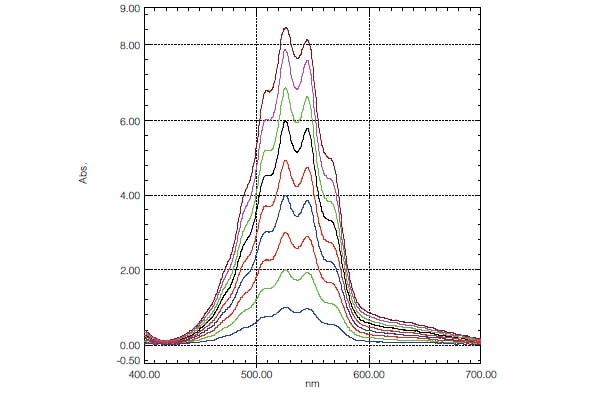Characteristics of Single and Double Monochromator UV-VIS Spectrophotometers
Two types of UV-VIS Spectrophotometers are available: the single monochromator type and the double monochromator type. As the names suggest, the single monochromator type contains one monochromator, while the double monochromator type contains two. But why are two types available? This explains the reasons and introduces the characteristics of each type of instrument.
1. What Is a Monochromator?
A monochromator is a mechanism that emits monochromatic light from a light source. A dispersive element, generally a prism or diffraction grating, is used to create the monochromatic light. A prism splits light into a spectrum by exploiting the fact that the refractive index differs according to the wavelength when light passes through glass. A diffraction grating has parallel grating lines ruled on the surface. The serrated grating lines cause the reflected light to diffract and split into a spectrum.
Fig. 1 shows schematic diagrams of monochromators based on a prism and diffraction grating.

Fig. 1 Principles of Monochromators
2. Stray Light
Monochromatic light exiting the monochromator slit contains a small amount of light at wavelengths besides the target wavelength. This light is known as "stray light." If the monochromatic light shone onto the sample contains 0.01% stray light and if the measured sample has a 3 Abs peak (0.1% transmittance) at that wavelength, then the 0.01% unabsorbed stray light is added to the 0.1% transmitted light, resulting in 0.11% transmittance. This converts to a measured absorbance of 2.959, which is 0.041 lower than the actual absorbance.
Fig. 2 shows an example of absorbance measurement of potassium dichromate. It is apparent that the measured absorbance is lower than the actual absorbance when the incident light includes stray light.
A double monochromator spectrophotometer with extremely low stray light is used for measurements of samples with high absorbance, as shown in Fig. 2.

Fig. 2 Effects of Stray Light Measurement of Potassium Dichromate
3. Configuration of Single and Double Monochromator Instruments
Fig. 3 shows the difference in construction of single monochromator and double monochromator instruments.

Fig. 3 Construction of Single and Double Monochromator Instruments
In contrast to a single monochromator instrument, a double monochromator type contains two monochromators in series. Light split into a spectrum by the first monochromator (Monochromator 1 in the diagram above) is split further in the second monochromator (Monochromator 2) to create purer monochromatic light with reduced stray light.
4. Optical Layout and Characteristics of Single and Double Monochromator Instruments
Fig. 4 shows optical path diagrams for Shimadzu UV-2600 and UV-2700 UV-VIS spectrophotometers.

Fig. 4 Optical Path Diagrams for UV-VIS Spectrophotometers
4-1. Characteristics of Single Monochromator Spectrophotometers
The single monochromator type offers a brighter optical system than double monochromator instruments. It is suitable for measurements involving high light losses, such as spectral measurements using an integrating sphere attachment on transmissive or reflective samples that scatter light or measurements of small samples with a finely collimated light beam.
Fig. 5 shows accessories for single monochromator measurements.

Fig. 5 Accessories for Single Monochromator Spectrophotometers
4-2. Characteristics of Double Monochromator Spectrophotometers
The double monochromator spectrophotometer achieves high linearity by ensuring extremely low stray light in comparison to a single monochromator system. This type of instrument is suitable for measurements of high-concentration sample solutions and low-transmittance materials, such as optical filters.
Fig. 6 shows the measurement of a sample with high light absorbance. It is apparent that the Shimadzu UV-2700 double monochromator UV-VIS spectrophotometer is able to measure 8 Abs absorption spectra.

Fig. 6 Measurement of Concentrated Potassium Permanganate
5. Summary
This article discussed the characteristics of single monochromator and double monochromator spectrophotometers. To achieve highly accurate spectral measurements, it is best to fully understand each spectrophotometer’s characteristics and to use the one most suitable to the sample properties and aim of the measurements.






